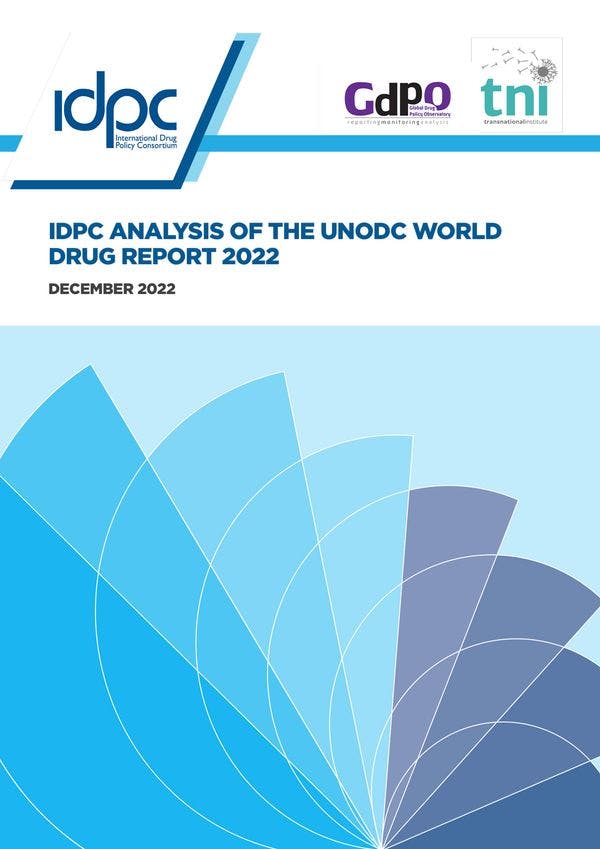IDPC analysis of the UNODC World Drug Report 2022
Drafted by Sylvia Kay (Transnational Institute) with contributions from Marie Nougier (IDPC).
Executive summary
The 2022 World Drug Report was released at a moment marked by the aftermath of the COVID19 pandemic, global economic turmoil, multiple armed conflicts, a climate emergency, and increasing calls to end the so-called ‘war on drugs’. And yet, the Report’s conclusions and policy recommendations disappointingly keep to ‘business as usual’, by refusing to contemplate alternatives to criminalisation and interdiction.
For the first time in the history of these annual reports, the United Nations Office on Drugs and Crime (UNODC) dedicates its thematic chapter to the issue of drugs and the environment, with the UNODC coming to the welcome conclusion that the international community should ‘mainstream the objective of “do no harm to the environment” in drug policy responses’. While the Report provides important takeaways, it also contains significant blind spots and questionable assertions that are highlighted in our analysis.
Firstly, the Report’s claim that damage to the environment is mostly identified in areas with little to no State presence should be questioned. In fact, recent research has pointed out that rural and underdeveloped regions are not defined by State absence, but rather by particular modalities of State presence, and that such State intervention can have equally, or even greater, damaging impacts on the environment as State absence, for instance by undermining modes of rural governance and environmental protection associated to farmer and indigenous land control.
Secondly, the Report fails to acknowledge the harmful effects of the ‘war on drugs’ approach for the environment, especially with regards to its discussion – and questioning of the mere existence of – the ‘balloon effect’. In the context of crop cultivation, the ‘balloon effect’ refers to the displacement that follows the forced eradication of illegal crops, with efforts to eliminate cultivation in one area simply leading to cultivation shifting elsewhere, and driving ecological harms such as deforestation. Contrary to what the World Drug Report suggests, the balloon effect is a well evidenced phenomenon, and it should be taken into consideration when assessing the environmental impacts of responses to cultivation.
Thirdly, the UNODC offers questionable comparisons of the carbon footprint associated with the production of cannabis, cocaine and cocoa beans. This analysis is problematic in many respects, including the fact that calculation of the carbon footprint of cocaine includes the impact of land deforestation whereas that is not included in the case of cocoa beans, and that cocoa beans and cocaine are simply not comparable products, as the former is a raw material whereas the latter is the result of a chemical and industrial process.
Fourthly, when discussing ‘community responses’ towards environmental protection, the Report fails to examine how different drug policy regimes impact on these community responses. These drug policy regimes are indeed a determining factor in shaping the prospects for addressing drug-related environmental challenges.
Finally, the Report refuses to acknowledge how legal regulation may address some of the environmental harms identified, for instance by allowing legal outdoor cultivation of cannabis in Global South countries that have traditionally produced the plant, which would have a much lower carbon footprint than indoor cannabis cultivation in the Global North. This, however, would also require addressing the tensions with the current UN drug control regime. It would also force a reckoning with the colonial legacy in drug policy narrative and practices – an issue that is entirely ignored in the 2022 World Drug Report.
To conclude, while the efforts made by the UNODC to consider the environmental impacts of drugs and drug policies may be laudable, the UNODC continues to be behind the curve as it refuses to acknowledge the severe consequences of the ‘war on drugs’ rationale, to challenge the range of human rights abuses associated with this approach, or to propose meaningful options for reform. Unless the UNODC aligns itself with the work of other UN entities to promote an approach to drugs truly grounded in human rights, health, development and environmental protection, there is a real risk that it will quickly get out of step with broader efforts to building a strong and unified UN response to pressing world challenges.
Previous reports in this series:
- The World Drug Report 2021: A critical assessment of projected increases in African drug use
- The World Drug Report 2020: Perspectives on markets, technology, and policy
- The World Drug Report 2019: Perspectives on protecting public health
- IDPC response to the 2018 World Drug Report
- IDPC response to the 2017 World Drug Report
- IDPC response to the 2016 World Drug Report
- IDPC response to the 2015 World Drug Report
- IDPC response to the 2014 World Drug Report
- IDPC response to the 2013 World Drug Report
- IDPC response to the 2012 World Drug Report
- IDPC response to the 2011 World Drug Report
- IDPC response to the 2010 World Drug Report
- IDPC response to the 2009 World Drug Report
- IDPC response to the 2008 World Drug Report
- IDPC response to the 2007 World Drug Report
- IDPC response to the 2006 World Drug Report
Regions
Related Profiles
- United Nations Office on Drugs and Crime (UNODC)
